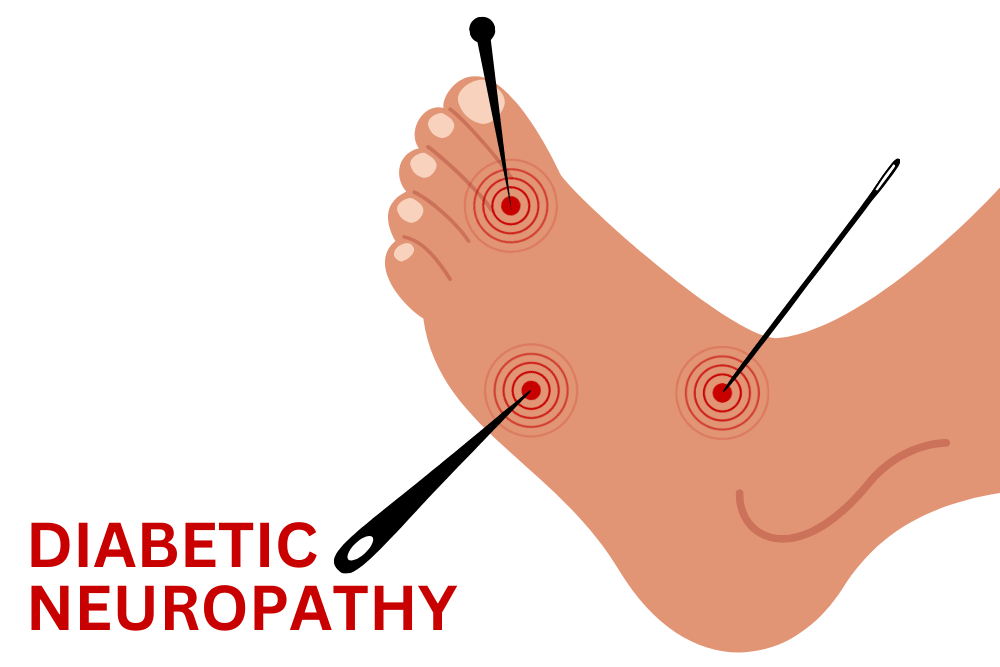GRID VIEW
Listen to the article here:
Diabetic Neuropathy is a nerve damage complication of Type 1 and Type 2 Diabetes. It is a result of high blood sugar (glucose) which harms nerves typically in feet and legs. Diabetic Neuropathy affects everyone differently, symptoms can range from mild to impairing as it can lead to problems in the digestive system, heart, urinary tract, and blood vessels. Diabetic Neuropathy is a serious health condition that affects about 50% of people who have diabetes.
There are four main types of diabetic neuropathy which have a variety of symptoms depending on the type and how a persons’ nerves are affected. Due to slow development of symptoms, a person is typically unaware that they have diabetic neuropathy until the nerve has suffered significant damage.
The four types of diabetic neuropathy:
Peripheral Neuropathy
This is the most common type and it first affects the legs and feet. It can progress to affect the hands and arms. Symptoms of peripheral neuropathy normally increase at night and include:
- Numbness to pain or temperature changes
- Tingling or burning sensation
- Cramps or sharp pains
- Muscle fatigue
- Overly sensitive to touch
- Foot problems inducing joint damage and infections
Autonomic Neuropathy
This type can affect nerves in the internal organs such as the heart, digestive system, sexual organs, sweat glands, and urinary tract. Signs and symptoms include:
- Unawareness of hypoglycemia
- Decrease in blood pressure that causes dizziness or fainting when standing up or sitting down
- Bladder or bowel issues
- Gastroparesis which causes nausea, vomiting, or loss of appetite
- Change in amount of sweating
- Problems in sexual response (differs in men and women)
Proximal Neuropathy (diabetic polyradiculopathy)
This is the most uncommon type and is seen in about 1% of people with type 2 diabetes. It results in problems with the nerves in legs, buttocks, thighs, or hips. Symptoms typically are on one side of the body but can spread to the other side. Symptoms include:
- Sharp pains in hip, thigh, or buttocks
- Weakness in thigh muscles
- Difficulty sitting upright after sitting
- Chest or abdominal pain
Mononeuropathy (focal neuropathy)
This type only affects one nerve at a time typically in the face, torso, arm, or leg. Symptoms can differ depending on the nerve being affected however they typically include:
- Difficulty focusing vision
- Paralysis on one side of face
- Tingling sensation or numbness in hands
- Weakness in hand and inability to hold objects
- Sharp pain in foot or shin
- Inability to lift front part of foot
- Pain in front of thigh
When diabetic neuropathy is diagnosed in early stages there is a higher chance that the medicine will be more effective. In order to diagnose diabetic neuropathy doctors often run tests and examinations such as:
- Checking muscle strength and reflexes
- Check muscle response to vibrations, temperature, and touch
- Ultrasound of urinary tract
- Electromyography to test muscles response to electrical currents
- Nerve conduction studies to evaluate flow of electrical current through a nerve
- Skin biopsy to determine cutaneous nerve innervation
- Muscle and nerve biopsies for histopathological evaluation
In addition to these tests and examinations, a doctor often tests blood glucose, blood pressure, and cholesterol in order to narrow down the root of the problem.
Treatment for diabetic neuropathy can sometimes be as simple as changes in lifestyle, however more serious stages of neuropathy require medications in order to manage symptoms and pain.
- In order to prevent further nerve damage a doctor will give you personalized blood sugar goals to decrease blood glucose levels. A few ways to manage glucose levels include developing healthier eating habits which include high amounts of protein and low amounts of carbs. Exercising regularly also manages blood sugar levels and increases insulin sensitivity.
- Controlling risk factors such as high blood pressure, high triglycerides, or cholesterol are a must when trying to relieve symptoms. Some ways to control these risk factors are by doing aerobic exercises daily, quitting smoking, and losing weight (if obese or overweight).
- Managing pain is achieved through different treatments such as medications.
Written by: Sofia H. Davila, Clinical Researcher.
Sources:
Mayo Foundation for Medical Education and Research. (2022, April 29). Diabetic neuropathy. Mayo Clinic. Retrieved February 23, 2023, from https://www.mayoclinic.org/diseases-conditions/diabetic-neuropathy/symptoms-causes/syc-20371580#:~:text=Diabetic%20neuropathy%20is%20a%20type,in%20the%20legs%20and%20feet.
“Diabetic Neuropathy.” Diabetic Neuropathy | Johns Hopkins Medicine, 18 Aug. 2020, https://www.hopkinsmedicine.org/health/conditions-and-diseases/diabetes/diabetic-neuropathy-nerve-problems.
Diabetic peripheral neuropathy is a type of nerve damage associated with diabetes that most commonly affects the peripheries of the body (toes, feet, legs, hands, and arms). Symptoms can range from mild to severe and can be painful, debilitating, or even fatal. The most common neuropathy symptom people seek medical attention for is pain. Since diabetic neuropathy currently does not have a cure, the best thing people can do is treat the pain and make sure their blood sugar levels are well controlled.
Diabetic neuropathy symptoms are often worse at night. Symptoms include:
- Lack of sensation to pain or temperature in those areas
- A tingling, burning or needle pricking feeling
- Sharp pain or cramps
- Extreme sensitivity to touch
- Problems with balance and coordination
People who have had diabetes for at least 25 years have the highest rates of nerve damage. Neuropathies are also more common in people who cannot keep their blood sugar under control, have high blood pressure, or are obese.
Current treatment options for pain are limited by poor effectiveness and high rates of side effects, leaving many patients without adequate pain control. With chronic use, nonsteroidal anti-inflammatory drugs (NSAIDs) pose a potentially serious gastrointestinal and liver toxicity risk. Opioids are commonly prescribed for moderate-to-severe pain but are limited by safety and tolerability issues and have high abuse rates. Opioid-associated death rates have also increased over the past two decades.
Given the limited treatment options, combined with the risks and ineffectiveness of currently available treatments, developing new treatments is vital for better pain management and health outcomes. We are involved in many cutting-edge research trials at ENCORE Research Group, and some of our locations currently have research studies for painful diabetic peripheral neuropathy. To learn more about participating in our cutting-edge clinical trials, call our main office today! (904)-730-0166





